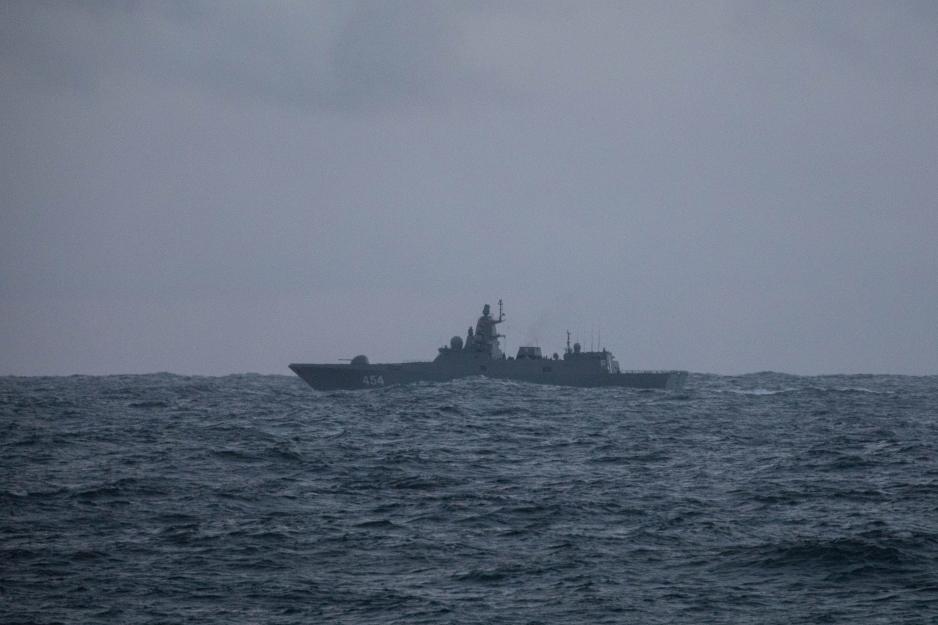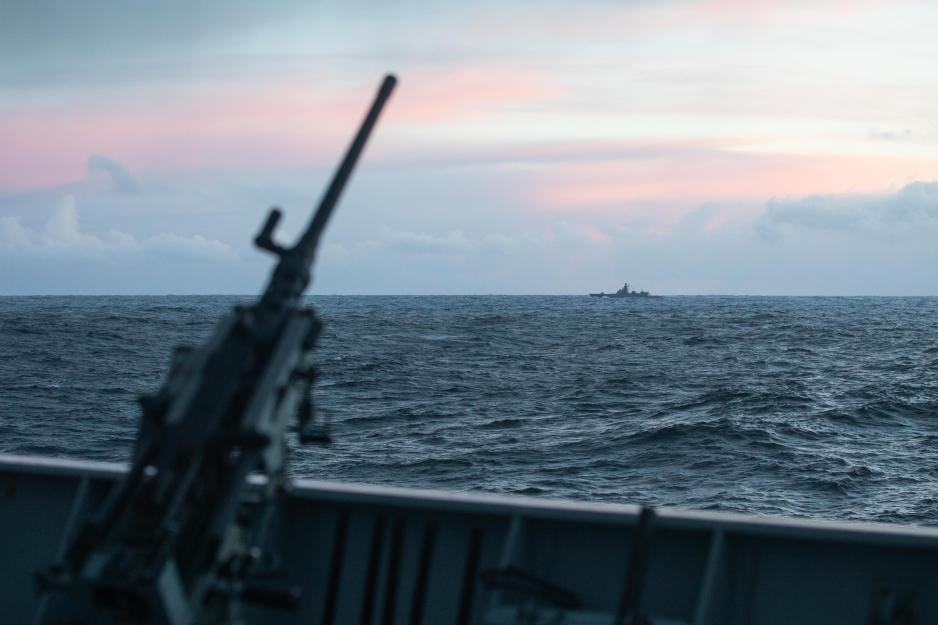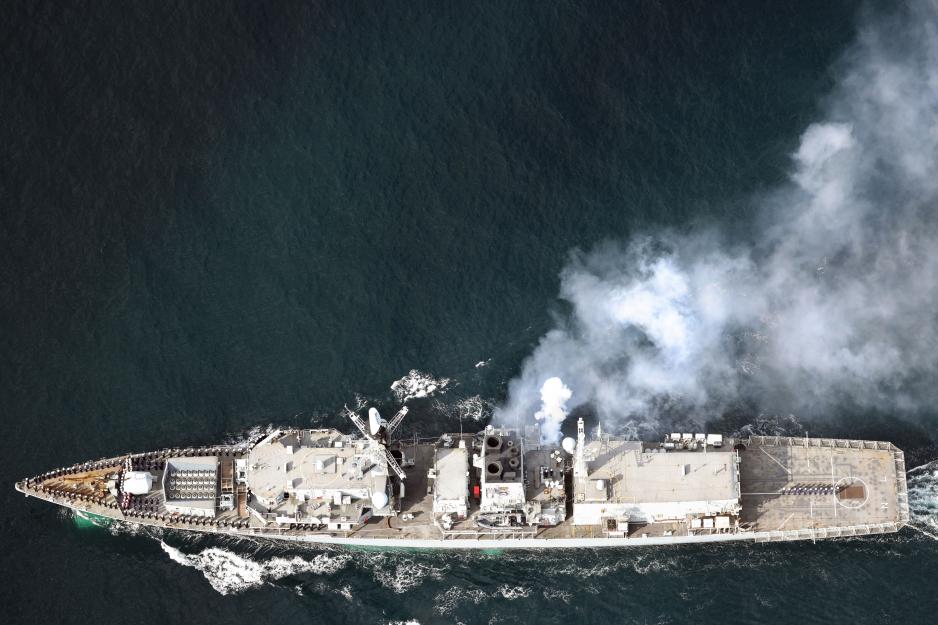The Norwegian Navy Followed Russian Frigate's Voyage North

The Russian frigate Admiral Gorshkov belongs to a new class of frigates that are equipped with very modern missiles. Here, the vessel is photographed outside the Norwegian coast heading north. (Photo: the Norwegian Armed Forces)
On Thursday, the Russian frigate Admiral Gorshkov sailed north in international waters outside the Norwegian coast. The voyage, presumably with the Kola Peninsula as its destination, has been observed by Norwegian military vessels.
The frigate KNM Fridtjof Nansen and the Coast Guard vessel KV Sortland followed the Russian combat vessel's voyage north, writes the Norwegian Armed Forces in a press release on Thursday afternoon.
"It is completely legitimate for Russians to sail in international waters. We have a good overview of what is happening outside our coast," says Commodore Trond Gimmingsrud, Chief of the Norwegian Navy.
The frigate Admiral Gorshkov belongs to the Russian Northern Fleet and has its home base on the Kola Peninsula, where it presumably has its destination, according to the Norwegian Armed Forces. Since the celebration of the Russian Navy Day in St. Petersburg on the 31st of July, the vessel has been undergoing maintenance at a shipyard in said city.
On Thursday night, Admiral Gorshkov was not to be found on MarineTraffic, an official ship tracking service that tracks ships with automatic identification systems (AIS) installed. The tracking service did, however, show that the aforementioned Norwegian military vessels had operated in the North Sea and south in the Norwegian Sea, before moving close to the coast of southwest Norway in the evening.

Observation of the frigate Admiral Gorshkov from the frigate KNM Fridtjof Nansen's side. (Photo: the Norwegian Armed Forces)
This Friday, KNM Fridtjof Nansen and KV Sortland have last been registered docked outside Bergen. One can therefore assume that their observation mission has been concluded and perhaps taken over by vessels further north.
The Norwegian Joint Headquarters (FOH) does not wish to say anything else about the observation of the Russian frigate's voyage outside the Norwegian coast than what is said in the press release.
"As long as it is in our vicinity, we will follow the voyage," writes the spokesperson at FOH, Corporal Jonny Karlsen, in an e-mail to High North News.
Still just as professional
Admiral Gorshkov complies with the Norwegian-Russian agreement called Incidents at Sea (INCSEA), reports KNM Fridtjof Nansen and KV Sortland. The agreement is meant to prevent dangerous incidents when the countries' military ships and aircraft operate near each other.
The INCSEA agreement was entered into in 1990 and updated in December 2021. In a time where the military activity in the High North is changing, this update constitutes an important contribution to security and predictability, said then Minister of Defense Odd Roger Enoksen (Center).
"Our experience is that the Russians are acting professionally and in accordance with our expectations. It is normal and it is always so," says the ship commander at KNM Fridtjof Nansen, Commander Senior Grade Stian Schnelle, in the mentioned press release.
The Norwegian-British patrol in the Barents Sea this fall also experienced professional and routine dealings with the Russian side. Then, the Norwegian frigate KNM Thor Heyerdahl and the UK frigate HMS Northumberland and logistics vessel RFA Tiderace were closely shadowed by Russian naval vessels.

The frigate HMS Northumberland is, according to the Royal Navy, deployed in Northern Europe and the Baltic Sea. Now in December, it is operating in Vestfjorden outside the Nordland coast in Northern Norway. (Photo: Owen Cooban/the Royal Navy).
British presence in the North
The same HMS Northumberland has been operating in Northern Norwegian waters since Monday and is still present in Vestfjorden, near the island Landegode in Northern Norway.
The vessel is participating in the Norwegian-led allied marine exercise Flotex 2022 with a northern center of gravity, but also with activity in the far south to ensure presence around oil and gas installations in the North Sea. It began on the 21st of November and will end on the 10th of December.
British participation in the exercise was originally not announced by the Norwegian Armed Forces, as Danish and German participation was.
"We see that the allies are increasingly looking north and wish to operate, train, and exercise more often in our vicinity. That is good and very much wanted by Norway," said the Chief of the Norwegian Joint Headquarters, Lieutenant General Yngve Odlo, at the end of November.
"Military operations in the High North can be challenging. If allies are to have the ability to operate successfully here, it is important to train in these areas regularly. This also applies to our own forces," Odlo added.
Also read
This article was originally published in Norwegian and has been translated by Birgitte Annie Molid Martinussen.



